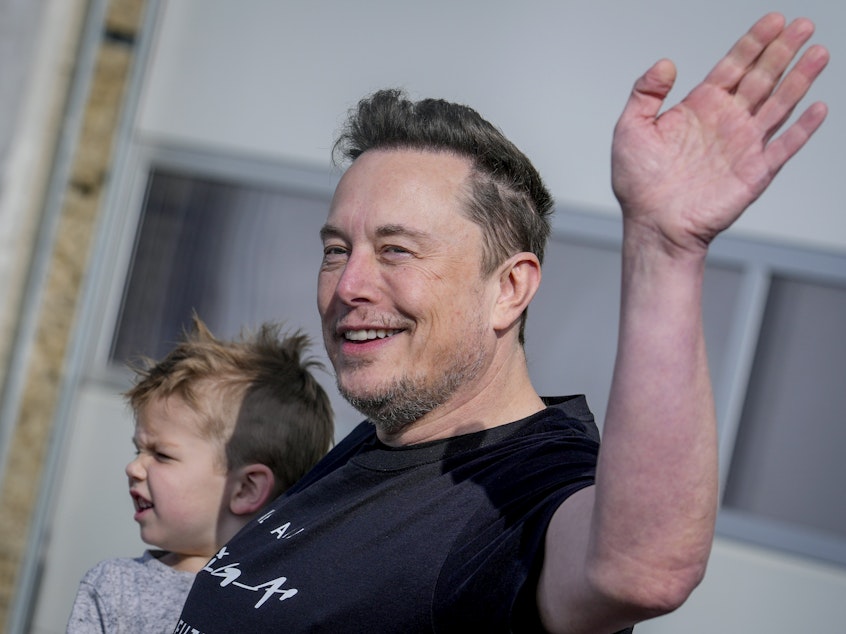Tesla profits have plummeted. Elon Musk remains all-in on robotaxis

After a barrage of bad news and a sharp drop in profits at Tesla, CEO Elon Musk sought to reassure investors on Tuesday that the revolutionary electric vehicle company is still on a long-term path to growth — thanks to AI and autonomous vehicles.
"We're putting the actual 'auto' in 'automobile,' " Musk said, to chuckles from his executive team.
"The future is really bright," Tesla CFO Vaibhav Taneja added later. "We just have to get through this period and get there."
"This period," though, is rough. Profits were down 55% for the quarter compared to a year ago, after sales decreased and Tesla repeatedly cut prices. A number of top executives are leaving, including the head of investor relations, who dropped that news on the Tuesday earnings call. Tesla is laying off more than 10% of its global staff, and executives are clamming up when investors keep pushing for more details about a long-promised $25,000 vehicle.
In defending the company's performance, Musk and other executives pointed to broader challenges in the EV industry, as well as headwinds like an arson attack at Tesla's Berlin plant and the cost of launching the Cybertruck. They also emphasized that they still see a bright future for electric vehicles.
The future of the $25,000 car is murky
In 2020, Tesla executives laid out a detailed argument for why they believed they could build a "compelling" EV with a price tag of $25,000. "This has always been our dream from the beginning of the company," Musk said. It's also a top priority for many investors and car shoppers.
The Model 3, the cheapest Tesla, currently starts at around $38,000.
How could Tesla cut prices to $25k? The plan involved casting a huge portion of the car as a single piece — similar to how a toy car might be manufactured. Later, Tesla executives also said they were rethinking the entire way an assembly line works as part of cracking the code for both this cheaper mass-market vehicle and a custom-built robotaxi.
Now, Tesla has essentially confirmed reports it's pivoting away from the mass-market vehicle portion of this plan.
But "more affordable" vehicles will still be offered before the second half of next year, Tesla maintains, using existing manufacturing lines. The "revolutionary" manufacturing process is now exclusively dedicated to the robotaxi.
How affordable is "more affordable"? Not clear. The cost savings may be smaller than previously expected, the company noted in its investor presentation.
When pushed on the timeline for that long-promised $25,000 vehicle, executives repeatedly redirected attention toward the equally-long-promised vision of robotaxis.
"The way to think of Tesla is almost entirely as solving autonomy, and being able to turn on that autonomy for a giant fleet," Musk said, in response to one question about the $25,000 car.
"I think we've said all we will on that front," he said to another.
Robotaxis are almost here — yet again
For years, Musk has promised that an army of robotaxis, driverless Teslas picking up passengers, is just around the corner.
On Tuesday he recommitted to that vision, promising that in August Tesla will reveal the "Cybercab," a vehicle custom-built for service as a taxi, as part of a fleet that could also include Tesla owners sending their cars out to make money a la Airbnb.
Today, Teslas with a pricey software add-on can drive themselves down city streets, stopping at stop lights and navigating turns without human input most of the time. But an attentive driver still needs to be in the front seat to take over when needed. Tesla has recently started referring to this software as "Full Self-Driving (Supervised)," acknowledging that it's not truly autonomous.
And operating a profitable robotaxi fleet is not just a technology problem. It requires working productively with government regulators and winning and keeping public trust — as GM's Cruise and Google's Waymo can painfully attest.
"I actually do not think there will be significant regulatory barriers, provided there is conclusive data that the autonomous car is safer than a human-driven car," Musk said, arguing that human drivers will be as outdated as human elevator operators.
Musk also sketched out a plan to use idle Teslas as a distributed AI computing business, similar in concept to Amazon Web Services cloud computing service. [Copyright 2024 NPR]
